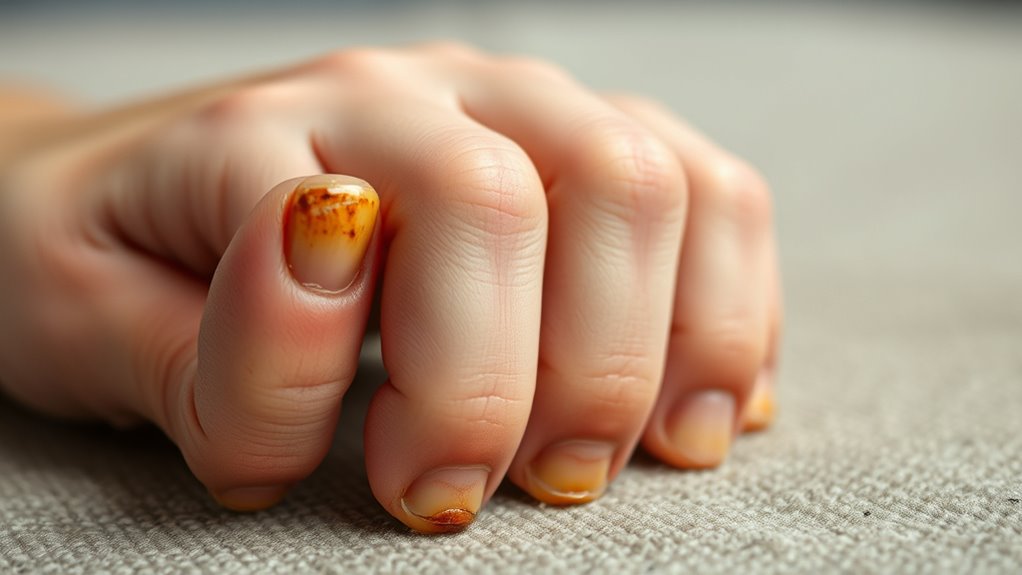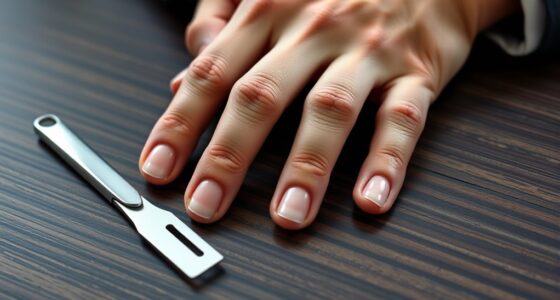Smoking damages your nails by causing yellow or brown discoloration from toxins like tar and nicotine, while also making nails rough, uneven, and more fragile. The harmful chemicals weaken nail strength and flexibility and reduce circulation, impeding healing. Over time, your nails can become thickened, brittle, or prone to peeling, and you’re more susceptible to infections. Staying aware of these effects can help you learn ways to protect and improve your nail health if you continue with this habit.
Key Takeaways
- Smoking chemicals like tar and nicotine stain nails yellow or brown over time.
- Toxins weaken nail structure, causing rough textures, bumps, and uneven surfaces.
- Reduced blood flow from smoking impairs nail healing, leading to brittleness and fragility.
- Increased infection risk due to immune suppression and skin cracks around nails.
- Quitting smoking and proper nail care can help improve nail appearance and health.
Why Smoking Causes Nail Discoloration

Smoking introduces harmful chemicals into your body that can stain your nails over time. These toxins, like tar and nicotine, settle into the nail beds, causing yellow or brownish discoloration. Poor nail grooming habits can make stains more noticeable, but quitting smoking helps prevent further damage. When you stop smoking, your nails have a better chance to recover, and discoloration can fade with proper care. Regular nail grooming, such as trimming and cleaning, also keeps your nails healthy and less prone to staining. The sooner you consider smoking cessation, the sooner you can reduce the buildup of stains and improve your nails’ appearance. Staying consistent with nail grooming routines enhances your overall nail health and supports your efforts to eliminate staining caused by smoking. Additionally, maintaining good hygiene practices can help prevent infections and keep your nails looking their best.
The Impact of Toxins on Nail Strength and Flexibility
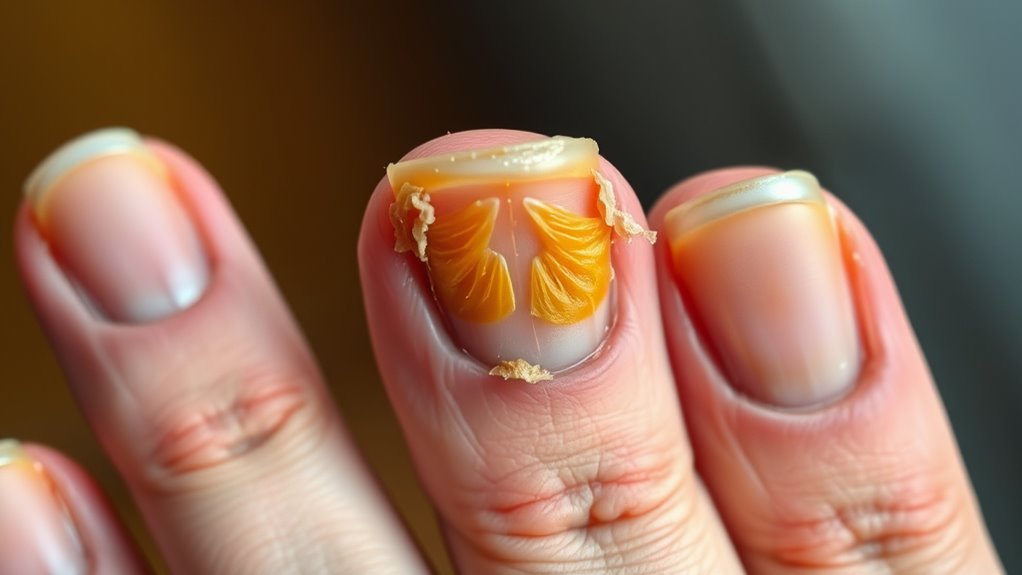
Toxins from smoking can weaken your nails by causing toxin buildup, making them more prone to breakage. Reduced collagen production also diminishes their flexibility, leading to brittle nails. As a result, your nails lose their natural strength and resilience over time. Additionally, the father’s guidance and support can influence your overall health, including nail condition, emphasizing the importance of a healthy lifestyle.
Toxin Accumulation Weakens Nails
As toxins build up in your body, they can directly weaken your nails, making them more prone to brittleness and breakage. Poor nail hygiene and neglecting nail grooming can accelerate this damage by allowing toxins and dirt to settle under your nails. To combat this, focus on maintaining clean, healthy nails. Incorporating proper dog grooming techniques can also help prevent the accumulation of harmful substances around your nails.
Here are three ways toxins affect your nails:
- Reduced resilience: Toxins interfere with keratin production, decreasing nail flexibility.
- Increased brittleness: Toxin accumulation makes nails dry and fragile, leading to more splits.
- Delayed healing: Toxins impair the nail’s ability to recover from minor injuries or damage.
Reduced Collagen Production Effects
Since collagen is essential for maintaining the strength and flexibility of your nails, any disruption in its production can weaken them considerably. Smoking introduces toxins that hinder collagen synthesis, leading to reduced collagen levels in your nails and surrounding skin. This decrease compromises skin elasticity, making your nails more prone to breaking and splitting. When collagen production slows, your nails lose their natural resilience, becoming brittle and less flexible. Reduced collagen not only affects the appearance of your nails but also makes them vulnerable to damage from everyday activities. Over time, the lack of adequate collagen can lead to persistent nail fragility and a dull, unhealthy look. Additionally, dental health can be indirectly affected by the impact of smoking on your skin and nails. Quitting smoking can help restore collagen synthesis, improving nail strength and overall skin elasticity.
Impaired Nail Flexibility
The chemicals in cigarette smoke directly weaken your nails by disrupting the structural proteins that provide flexibility and strength. As a result, your nails become more brittle and prone to cracking. Smoking reduces nail hydration, making nails less elastic and more susceptible to breakage. Poor cuticle care from smoking can further impair nail flexibility by allowing damage to penetrate deeper. To counteract this, focus on keeping your nails well-hydrated and maintaining proper cuticle care. Recognizing the signs of damage can help you take proactive steps to protect your nails from long-term effects of smoking, such as yellowing and brittleness. Nail health
How Smoking Leads to Brittle and Peeling Nails

Smoking damages your nails by restricting blood flow and introducing harmful chemicals that weaken the nail structure. When your nails don’t receive enough nutrients, they become brittle, prone to cracking, and easily peel. Poor nail grooming habits can worsen these effects, making nails look ragged and unhealthy. To improve nail strength, consider quitting smoking; smoking cessation allows better circulation and reduces chemical exposure. Proper nail care, like keeping nails moisturized and avoiding harsh products, also helps prevent peeling. Remember, consistent nail grooming supports healthier nails, especially as your body recovers from smoking’s damage. Additionally, nutrient deficiencies caused by smoking can impair nail health, making it even more important to maintain a balanced diet. By taking these steps, you’ll give your nails a better chance to regain strength and resilience over time. Quitting smoking is a vital move toward healthier, less brittle nails.
The Role of Reduced Circulation in Nail Health

Reduced circulation plays a crucial role in your nail health because it limits the flow of oxygen and nutrients necessary for strong, healthy nails. When circulation declines, tissue oxygenation decreases, impairing your nails’ ability to repair and grow effectively. This can lead to dull, brittle nails that are more prone to breakage.
Reduced circulation hampers nail repair and growth, leading to dull, brittle nails prone to breakage.
Here are key effects of circulation decline on your nails:
- Reduced delivery of essential nutrients, weakening nail structure
- Slower removal of waste products, leading to potential infections
- Impaired tissue oxygenation, hindering cell regeneration
Without proper circulation, your nails struggle to stay healthy and resilient. Smoking exacerbates this issue by constricting blood vessels, further reducing circulation and tissue oxygenation, which accelerates nail deterioration.
Recognizing Other Visible Changes in Smoker’s Nails
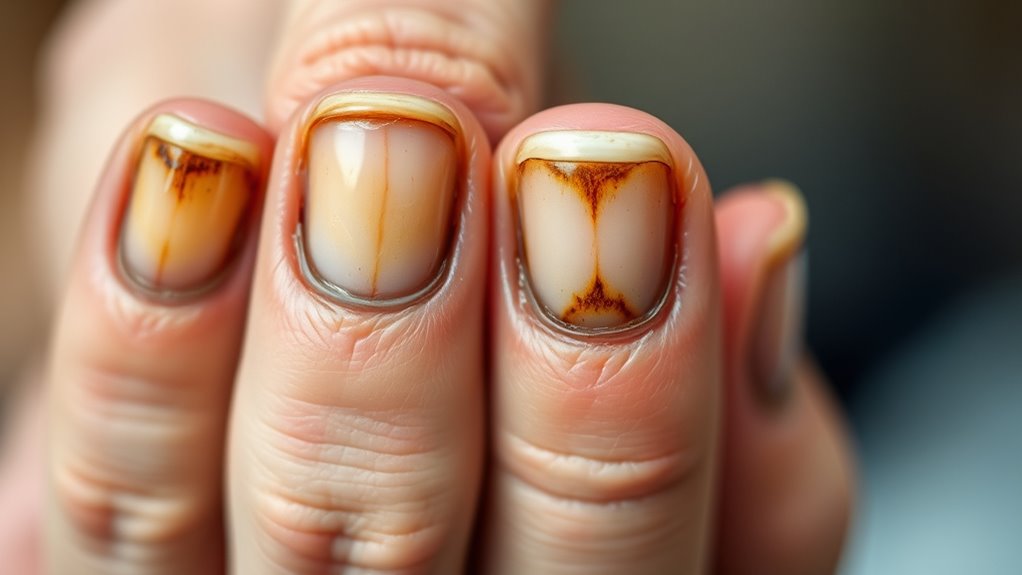
You might notice your nails have developed unusual discoloration patterns or become yellowed over time. Changes in texture or increased thickness can also signal damage from smoking. Paying attention to these visible signs helps you recognize the broader impact smoking has on your nail health.
Nail Discoloration Patterns
Have you noticed any unusual changes in the color of your nails? If so, it could be a sign of smoking-related discoloration patterns. These patterns vary and can include yellowish or brownish stains, streaks, or uneven patches. Recognizing these signs helps you understand your nail health better. To analyze discoloration: 1. Observe if the staining affects the entire nail or just parts, which can influence your nail polish choices and how you apply manicure techniques. 2. Look for streaks or lines that run vertically or horizontally—these may indicate deeper health issues. 3. Check for changes in the nail bed color, like darkening or dullness, which can signal ongoing damage. Being aware of these patterns helps you decide whether to seek professional advice or adjust your nail care routine. Additionally, understanding sound design techniques can help you create educational content or awareness campaigns about health indicators like nail discoloration.
Texture and Thickness Changes
Changes in the texture and thickness of your nails can be subtle but significant indicators of smoking-related damage. You might notice your nails becoming rougher, with a bumpy or uneven nail texture that wasn’t there before. Smoking can also cause your nails to become thicker or thinner than normal, signaling changes in nail health. These alterations occur because toxins from cigarettes impair nail growth and degrade the nail’s structural integrity. Thickened nails may feel harder or more brittle, making them prone to cracking or splitting. Conversely, thinner nails can appear fragile and easily damaged. Paying attention to these changes helps you recognize early signs of damage, prompting you to seek healthier habits. Changes in nail texture and thickness are important visual cues of how smoking impacts your nail health over time.
The Connection Between Smoking and Fungal Nail Infections
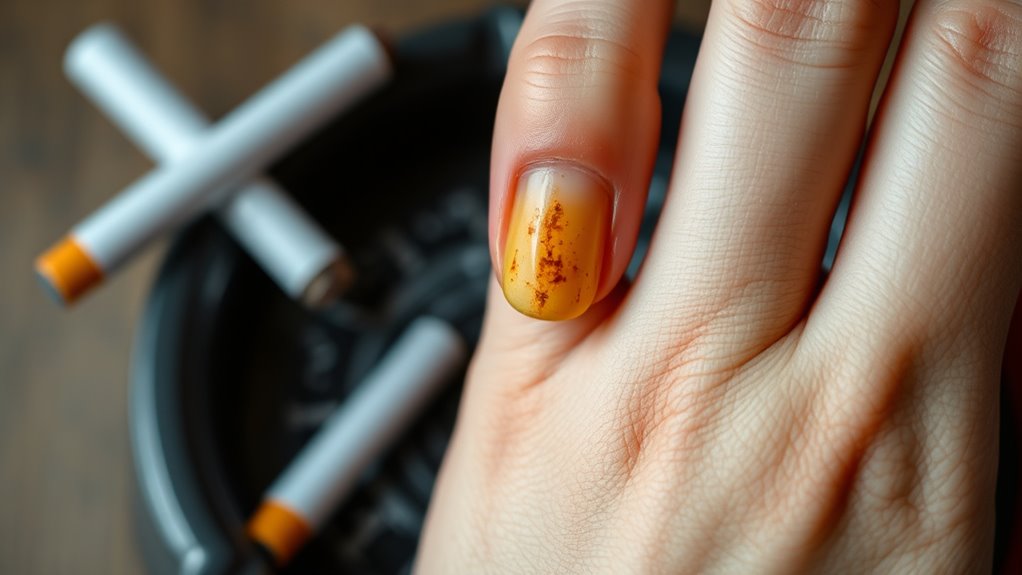
Research indicates that smoking can markedly increase the risk of developing fungal nail infections. Smoking damages your immune system, making it harder for your body to fight off fungi. Additionally, tobacco and nail infections often stem from poor circulation, which smoking worsens. This reduced blood flow affects your cuticle health, creating cracks and openings where fungi can enter. Moreover, Entertainment and Parks venues often implement health protocols to reduce the spread of infections, highlighting the importance of maintaining good nail health. To understand this connection:
Smoking impairs immunity and circulation, increasing fungal nail infection risks.
- Smoking weakens the skin around your nails, reducing natural defenses against fungi.
- Tobacco use impairs immune response, making infections more likely and harder to heal.
- Poor circulation from smoking hampers the delivery of nutrients needed for nail repair, increasing the risk of fungal growth.
Tips for Protecting and Improving Nail Health While Smoking

While smoking can weaken your nails and increase infection risk, there are practical steps you can take to protect and improve their health. Regular nail grooming helps keep nails clean and prevents damage or infections that smoking can cause. Trim your nails straight across and avoid biting or picking at them. Maintaining good hygiene minimizes dirt buildup and fungal risks. Smoking cessation is the most effective way to reduce further damage and yellowing. Quitting smoking allows your nails to recover over time, improving their strength and appearance. Additionally, using nourishing cuticle oils or moisturizers can promote healthy nail growth. Staying hydrated and eating a balanced diet also supports nail health. Incorporating antioxidant-rich foods into your diet can help combat oxidative stress caused by smoking, which negatively affects nail quality. By combining proper nail grooming with efforts to quit smoking, you give your nails the best chance to recover and stay strong.
Frequently Asked Questions
Can Quitting Smoking Reverse Nail Discoloration?
Yes, quitting smoking can help reverse nail discoloration over time. With smoking cessation, your body starts to heal, and your nails can gradually regain their natural color. Regular nail whitening treatments and good hygiene also assist in improving their appearance. While it may take a few weeks or months, stopping smoking is a vital step toward healthier nails and preventing further discoloration, giving you a chance to restore their natural look.
Are There Specific Nail Care Products That Help Smokers?
Like a knight’s armor, specific nail care products can protect your nails. Look for those with nail strengthening ingredients like keratin or biotin, and opt for cuticle nourishment oils to revitalize your nail beds. These products help combat damage from smoking, restore flexibility, and improve overall appearance. Consistent use can make a noticeable difference, helping your nails regain strength and health despite past habits.
How Quickly Do Nail Changes Appear After Starting Smoking?
Once you start smoking, nail changes can appear surprisingly quickly, often within a few weeks to a couple of months. The smoking timeline for nail change onset varies depending on factors like smoking frequency and your body’s response. You might notice yellowing, ridges, or brittleness early on. Staying aware of these signs helps you catch issues promptly, but quitting smoking can halt or reverse many of these nail-related effects over time.
Do E-Cigarettes Affect Nail Health Similarly to Traditional Cigarettes?
Think of e-cigarettes like a storm cloud over your nail health—while they lack tar, the chemicals in e-cigarette vapor can still harm your nails. Studies show e-cigarette chemicals may cause yellowing and brittle nails similar to traditional smoking. However, some nail health improvements happen when you cut back or quit vaping. While less damaging overall, e-cigarettes still pose risks to your nails, so reducing use benefits your nail health.
Is There a Link Between Smoking and Nail Pigmentation Disorders?
Yes, smoking can cause nail pigmentation issues, such as brown or yellow stains, due to the chemicals in tobacco. Smoking and nail health are linked because nicotine and tar can stain nails and weaken their structure. Additionally, addiction to smoking may reduce blood flow, impairing nail growth and healing. If you want healthier nails, quitting smoking is essential, as it helps prevent pigmentation problems and improves overall nail health.
Conclusion
Thinking about the toll smoking takes on your nails, it’s clear that the damage goes beyond just appearance. From yellowing and brittleness to increased infection risk, your nails reveal the hidden costs of smoking. Why not give your nails the care they deserve and consider quitting? Protecting and improving your nail health starts with awareness—so, are you ready to make choices that keep your nails vibrant and strong?
